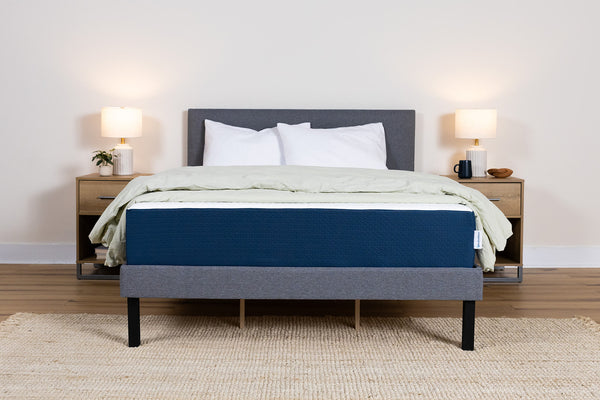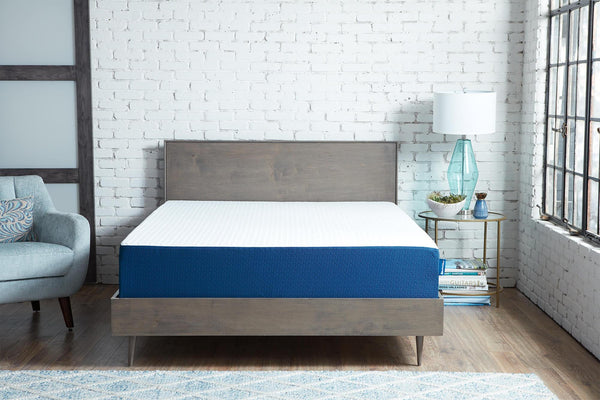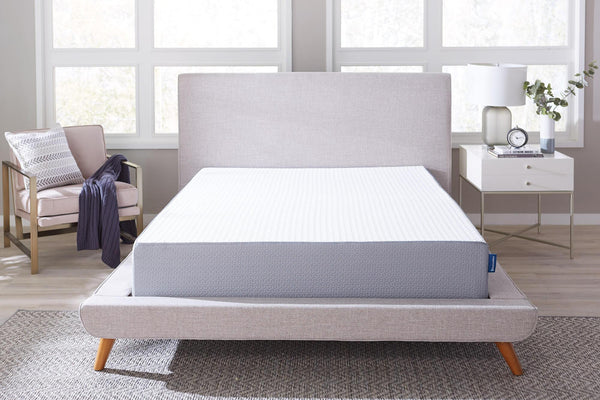Creating A Healthy Sleep Environment

There are multiple elements that go into creating a healthy sleep environment. Of course, you have to take the quality of your mattress and bedding into consideration, but it is also important to consider your environment as a whole. Below, we will explore the different aspects of a sleep environment and how to curate a space that will help create a peaceful sleep environment that will keep you well rested.
Contents
Bedding & Comfort
Your mattress is the foundation of your sleep, so it is important to have a comfortable and supportive mattress. Mattresses come in a variety of constructions including memory foam, latex, and traditional innerspring. BedInABox® memory foam mattresses provide the perfect balance of comfort and support. Our mattresses don’t have the high price tag of latex foam and are more durable than traditional innerspring mattresses. An easy way to add comfort and support to your existing mattress is with a mattress topper. Mattress toppers are an alternative to buying a new mattress and can also help extend the life of your current mattress. A quality pillow and breathable bedding that keeps you supported, cool, and comfortable are also essential. BedInABox® has all of the mattresses and sleep accessories that you need to create a comfortable bed setup.
Cleanliness
Keeping your sleep space clean and free of clutter is key to creating a relaxing and healthy sleep environment. Keeping paperwork, homework, mail, dishes, and other clutter in a separate area will help keep your sleep environment stress free. One way to help keep your sleep space clean stress-free is to avoid using your sleep area as a workspace. Another great way to help promote relaxation and induce sleep is to keep decorations to a minimum while also choosing calming color schemes for décor and wall color. Rooms with silver decor make the space feel luxurious and glow like moonlight, which can trick the eyes and the brain into going into nighttime mode.
Lighting
Based on the 2011 National Sleep Foundation’s Annual American Sleep Poll, 95% of people aged 13-63 reported that they fell asleep with the television on. Bright lights from a television screen can be very disruptive for sleep. Light reduces natural melatonin production in the brain, which is the hormone that induces sleep. Ditching other electronics such as cellphones, tablets, laptops, game consoles, or e-readers can help keep disruptive lighting to a minimum and create less distraction in your sleep environment. In order to prevent disruption from outdoor lighting, consider adding blackout curtains or drapes to your windows.
Room Temperature
The ideal room temperature for sleeping is around 65 degrees. A sleep environment that is too hot or too cold can lead to either sweating or shivering which can disrupt or prevent sleep. The right combination of room temperature, pajamas, and blankets can create the perfect sleep environment.
Noise
Falling asleep with the television on cannot only be disruptive because of the light, but also because of the noise. Noise can be very impactful on sleep. Relaxing noises can help induce sleep while aggressive noises can disturb sleep. Noise sensitivity varies from person to person, so try out different things to see what works for you. Any sound that you use at night should be consistent and set to a low level. Any loud or sudden sounds can spike your heart rate which can cause you to wake up. Using ear plugs and turning off any non-essential cell phone noises and alarms will help eliminate these loud and sudden noises. Consistent noise such as traffic, a fan, or a clock are noises that most people adjust to over time and are less likely to wake you.
Sleeping With A Partner
Sleeping with a partner can lead to both relationship and sleep issues. Even peaceful sleepers can toss and turn up to 50 or 60 times in one night, waking up anyone sleeping in bed with them. If your partner snores, that can also disrupt both their and your sleep. Consider a BedInABox® adjustable bed frame to help with snoring. Another bedmate that can disrupt sleep is a pet. Pets can make noise and move around the mattresses all night long. It is best to keep pets in their own sleep spaces in order to optimize your own.
Aromatherapy
Using aromatherapy in your sleep environment can also help promote sleep. Research has shown that certain scents, such as lavender and vanilla, can help promote sleep. Aromatherapy creates a relaxing and calming atmosphere, which can help you to wind down and fall asleep. Utilizing aromatherapy can also help create a routine, which your brain will use as a cue that it is time for bed. Aromatherapy can also be used to help with depression, anxiety, and other disorders that can impact sleep and stress. Aromatherapy can also help mask any unpleasant smells that may occur during the night and disrupt sleep.
Effects Of Color On Sleep
Different colors produce different sensations in our brains, and these sensations can lead to different moods. This means that color can have a powerful influence on our moods and can impact how we act and react. Color has also been shown to have an influence on blood pressure and metabolism. But what effect does the color of our sleep environment have on our sleep?
Blue
One color that can create a better sleep environment is the color blue. On average, people with a blue sleep space get more sleep than others.
Yellow
Another color that can aid sleep is the color yellow. Despite it being a brighter color, yellow is shown to stimulate the nervous system, which aids relaxation, while also creating a warm and cozy atmosphere.
Green
A green room is the third most popular sleep inducing color. Green creates a restful, calming environment which helps relaxation and promotes sleep.
Orange
An orange bedroom is another one of the most popular sleep inducing colors. Orange adds warmth to a room which can make it feel like a stable and reassuring space. The color orange can also help with digestion, especially if you have eaten a large or late evening meal.
Colors To Avoid
Colors to avoid in your sleep space are purple, brown and gray. These colors are more likely to promote vivid dreams or even nightmares, resulting in disrupted and stressful sleep. Adjusting the color of your sleep environment can have a major impact on your quality of sleep. The color of the sleep environment is often overlooked by troubled sleepers and changing it can improve sleep disorder symptoms and overall well-being. Be sure to select a color that will help induce sleep.
Sources
Elliot, Andrew J., and Markus A. Maier. "Color and Psychological Functioning." Current Directions in Psychological Science 16.5 (2007): 250-54. Web.
Travelodge. The Secret To A Good Night's Slumber Is To Sleep In A Blue Bedroom. [Press release] 17 May 2013. Web. 8 Oct. 2014.
Whitfield, T.W., & Wiltshire, T.J. (1990). Color psychology: A critical review. Genetic, Social & General Psychology Monographs, 116, 387–412.
Complete your sleep setup with savings on mattresses, bundles, adjustable beds and other sleep accessories during our Black Friday Sale.


